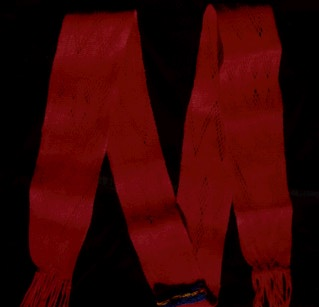Patterned Sprang
Basic (closed) sprang:
- 2F/B (F/B) F/2B
- F/B
Open sprang:
- 2F/2B
- F/B
- F/B (2F/2B) F/B
- F/B
Patterns are read from right to left.
- F/B = pick up one thread from the back, drop one thread from the front
- F/2B = pick up 2 threads from the back, drop one thread from the front
- repeat items in ( ) as needed
If this is confusing, refer back to basic sprang.
Patterns
The basic and open sprang techniques can be combined to make lacy patterns. Diagonal patterns are best, since the rows of holes are staggered. These directions are for a diamond figure of open holes on a tight background. The sample warp has 20 strands (10 front, 10 back), and the diamond looks like this:
O
O O
O O O
O O
O
Directions:
- 2F/B (F/B) F/2B
- F/B
- 2F/B F/B F/B F/2B 2F/B F/B F/B F/2B
- F/B
- 2F/B F/B F/2B 2F/2B 2F/B F/B F/2B
- F/B
- 2F/B F/2B 2F/2B 2F/2B 2F/B F/2B
- F/B
- 2F/B F/B F/2B 2F/2B 2F/B F/B F/2B
- F/B
- 2F/B F/B F/B F/2B 2F/B F/B F/B F/2B
- F/B
- 2F/B (F/B) F/2B
- F/B
All the pattern changes are done in odd-numbered rows. I think of my sprang as growing from the top down, so this explanation reflects that. Holes can be thought of as in columns which skip every other row.
Row 3: To start a hole, treat the warp as two separate sections of basic sprang, ending one section before starting the next. (To start with more than one hole, add (2F/2B) for as many holes as you want.)
Row 5: To add a hole directly to the right of an existing hole, and in the row below, continue normally until there are 5 threads (including top and bottom) left before the hole. Then sprang 2F/B to end the section and add a new hole.
To close a single hole temporarily (while keeping its column), close the hole with 2F/2B.
To add a new hole to the left of an existing hole, after closing the hole, begin the next section of basic sprang with F/2B.
Row 7: Add a new hole to the right, temporarily close the previous holes, add a new hole to the left.
Row 9: Close the rightmost column of holes permanently by continuing the basic sprang until only one thread remains before the hole, then close the hole with 2F/B. Keep the central two holes by closing them with 2F/2B.
Close the left hole with a F/2B to remove the column permanently.
Row 11: Close the right and left columns of holes, keeping the middle one.
Row 13: Return to basic sprang, closing the last hole.
A wide variety of diagonal patterns can be made, as in this detail from a sprang baldric:

